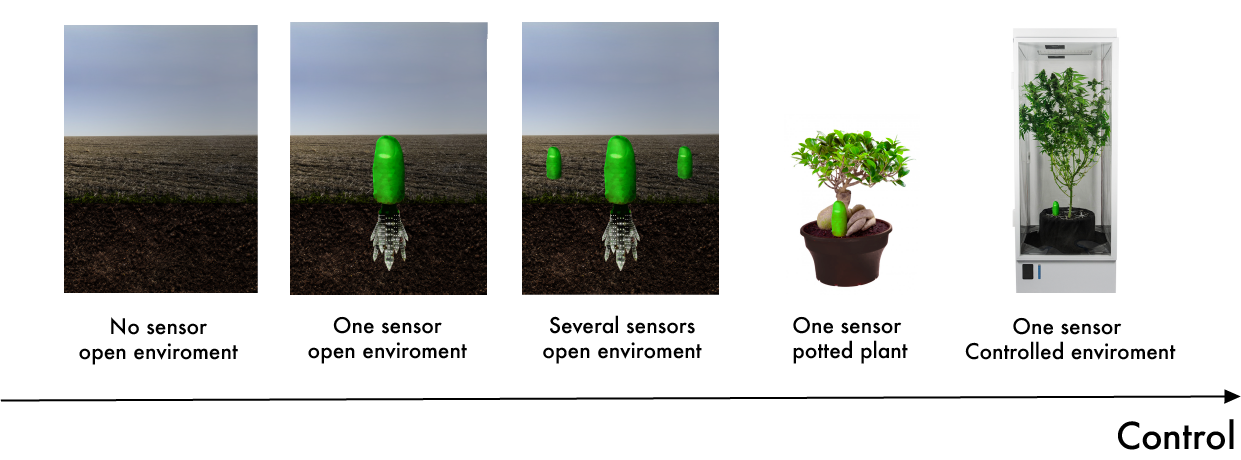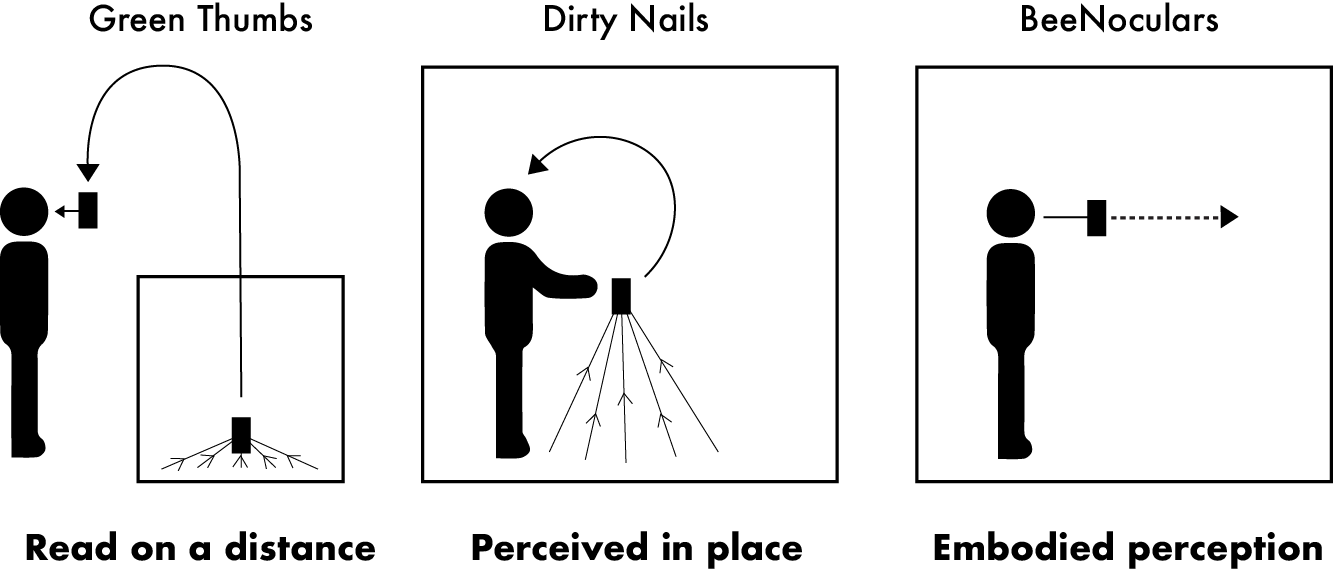Green Thumbs
This project explored how speculative design can further findings from an ethnographic participant observation study of urban community farmers. The speculative designs point to possible futures, that each highlight different needs, values, norms, behaviors and attitudes of urban farmers. Three approaches to growing are highlighted with a corresponding design (1) the approach of “Controlling” through the Green Thumbs design (2) the approach of “Sensibility” through the Dirty Nails design and (3) the approach of “Appreciating” through the BeeNoculars design. The speculative designs focus on the possibilities of sensing technologies to support the noticing of environmental conditions. This project is discussed in more detail in the NordiCHI paper"Noticing the Environment – A Design Ethnography of Urban Farming".

The Green Thumbs speculative design poster, as shown to the participants.
A Controling aproach to cultivaiton
The Green Thumbs design is based on a ‘controlling’ approach towards cultivation that emerged in analysis of data from participant observation of urban framing. This approach aligns with dominant modes of agricultural production where sensors, AI, and IoT are already implemented to optimize growing conditions in industrial farming through ‘AgTech’. These approaches aim to decrease the complexity of the cultivation ecology (through e.g., industrial monoculture and genetic modification) in order to control and measure the whole cultivation process, thus supporting more consistent modes of production.

Increasing degrees of control through design
Grounding in community practices
Many urban farmers were interested in concrete data about the cultivation. Some sensing practices were quite simple such as measuring temperature in compost to take proper actions of care. Other practices were more advanced such as creating controlled and automated indoor growing environments with sensors and actuators where liquid fertilizers were added in exact amounts. Common for the urban farmers who were practicing measuring was their inclination towards discussing data and best practices for maximizing crop yield.
Design Description
Green Thumbs (See Figure 3) senses Ph-value, moisture, oxygen, phosphorus, potassium and nitrogen in soil in addition to temperature, light, humidity and carbon dioxide in air. Several Green Thumbs may be connected in a network to sense the growing conditions of a larger cultivation. The data is sent wirelessly to the social media application Common Ground where suggestions on how to improve growing conditions based on the current data are generated both by an Artificial Intelligence (AI) and by a community of users practicing cultivation. The suggestions can be filtered by different philosophies of cultivation including permaculture, genetic modification, industrial monoculture, companion planting, bio dynamics and ecological farming. In an interface prototype (shown to the participants), the filter ‘industrial monoculture’ displays an AI-based suggestion to “add 1 dl liquid nitrogen fertilizer” to increase nitrogen while the filter ‘ecological farming’ displays suggestions from users in the community of various types of composting or using diluted urine to increase nitrogen. These suggestions are fictional but based on real observations. Users can vote on the quality of suggestions by giving them a “green thumb” or a “red thumb”. The track record of how users’ suggestions have been assessed by others is displayed in adjunction to their profile picture.
Participant responses
All participants highlighted the practical benefits of the Green Thumbs concept and were positive towards the idea. Nevertheless, they were not sure if the product should be developed due to sustainability concerns. One urban farmer addressed the negative environmental impact of producing new technologies “I like the idea of creating a network of sensors, but it seems very expensive and wasteful to produce all these sensors” (M2). Another urban farmer worried about a more specific environmental impact “would the wireless signals damage insects?” (W2).
Setting environmental concerns aside, one urban farmer expressed that “it feels like a precision tool when you really want to be sure that the crop will have a certain nutrient for it to be optimal” (M1). Another urban farmer commented“It’s clever, the name, it’s almost like you can have a green thumb [intuitively know how to care for plants], even if you really don’t” (M2). However, the extent to which the urban farmers would use the tool was challenged by some who highlighted that they did not have time or energy to thoroughly monitor and control their cultivation “you can only cope scientifically to a certain point, then I let it be”(W1).
Further, the different philosophies presented in the associated Common Ground application spurred discussion, as expressed by a participant “it is interesting to present the philosophies in this way” (M2). Some participants advocated for ‘their’ philosophy of permaculture, while others were more open to a diversity of philosophies. One urban farmer reflected “the philosophies seem to have a goal conflict, or how you get there. I don’t know, I get the feeling that if you had Green Thumbs it would be like a path for them to meet /…/ Green Thumbs feels like a scientifically developed thing that would lead to concrete answers to these questions” (M1). Another participant raised a concern for how diverse philosophies and focus on data may contribute to portraying cultivation as overly complex“Is it only I who think that it is harder to cultivate the more you learn? It’s good with data but not necessary /…/ I want to tell all beginners to not be scared because of complex instructions. Continue to experiment and be happy about that which succeeds” (W2).
Social construction of cultivation knowledge
Green Thumbs presents the cultivation ‘as data’ and focuses on the social construction of cultivation knowledge, particularly in terms of how much the environment can or should be controlled.
The filter functionality of the web application illustrates how different philosophies of cultivation produce different practices related to the same ‘issue’ in the cultivation. For example industrial monoculture produces different suggestions than permaculture, companion planting, anthroposophy and ecological farming that appreciate, foster and develop relationality in cultivation. In these philosophies the goal is to create conditions where relational processes in ecologies thrive, rather than controlling exactly what is going on
Various philosophies, approaches and best practices co-exist and are juxtaposed with each other in the speculatie interface. On the one hand this highlights that there are diverse philosophies for growing, and ways of responding to the sensor data. On the other hand, the voting system of the interface highlights the politics of farming, suggesting that there are better and worse ways to farm
The design was expressed by the participants to portray cultivation as an expert practice with many ‘rules’ and different philosophies that some urban farmers worried might discourage beginners to cultivation. Overall, the design illustrates how the underlying philosophy matters for what is noticed in a cultivation and how this is interpreted.
While the Green Thumbs design portrays cultivation as a complex practice, it simultaneously ignores other aspects of cultivation. Through focusing only on what is numerically measurable with sensing technology, the design partly simplifies the complex reality of cultivation. The device excludes other commonly discussed growing conditions found in the data such as insects, pests and soil microbes. These conditions are more complex for digital devices to sense and interpret, since there is no single measurement that can make perceptible, for example the processes between billions of microorganisms in soil or the visual and chemical communication between insects and plants. As such, the design illustrates the varying degree in which urban farmers aim to control the environment and how interactive design may provide some control, while the perceived control may simultaneously be deceptive given the complex reality of cultivation.
Critical reflections
I set out to illustrate a limiting ‘controlling’ approach to cultivation that turned out to actually support more nuanced discussions about best practice based on a variety of philosophies. When creating the Green Thumbs concept, I thought of it as the ‘conventional’ and even ‘boring’ design that would act as a juxtaposition to the two other designs presented in this paper. However, out of the three designs, the participants appreciated Green Thumbs the most. I had thus underestimated the value of a straightforward design concretely supporting the practice. Green Thumbs was further the most open of the three designs in terms of available data and possible uses. This illustrates the value of designing open-ended, multipurpose tools that users themselves can adapt to their practice. Lastly, some participants brought up technological concerns that should be taken seriously, such as whether wireless signals could damage organisms as there is scientific debate on this.

Comparing the relations to the environment that the speculative designs illustrate.